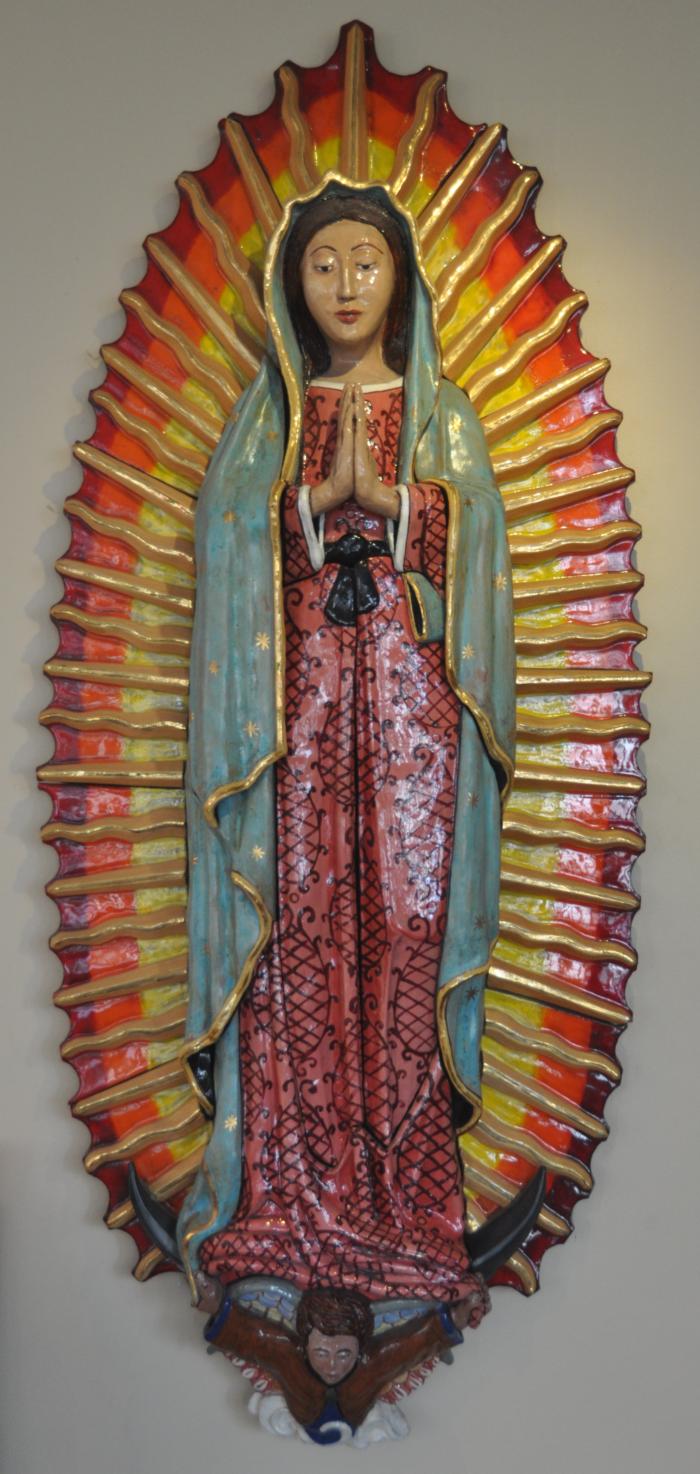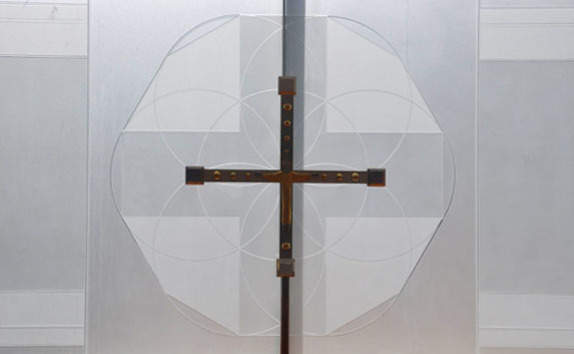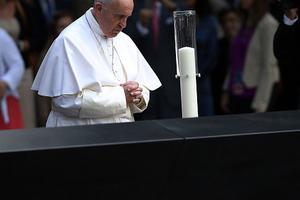A 9/11 Sacred Site Is at Risk in New York
COMMENTARY: St. Joseph’s Chapel is victim of skyrocketing rent.

A historic site’s worst enemy is a wrecking ball. But at an important spot in Lower Manhattan, a demolition crew isn’t the problem — it’s the landlord and rising rent.
St. Joseph’s Chapel has been part of daily life at Battery Park City since 1983. But that’s not what makes this little mission church significant. The chapel was built beside the World Financial Center and across the street from the Twin Towers of the World Trade Center.
When a terrorist attack brought down the towers and took the lives of more than 3,000 innocents on Sept. 11, 2001, St. Joseph’s was spared, but the rubble came literally right to the chapel’s front door.
Almost immediately, government agencies commandeered the chapel, ripped out the pews and used the little church as a makeshift supply center.
In the following months, the chapel became a place where firefighters, police officers, rescue workers and members of construction crews could get something to eat, get a little sleep and escape from the smells, the smoke, the dust and the heartbreak of sorting through the debris and ruins of the devastated towers.
Once residents of Battery Park City could return to their homes, the clergy of St. Joseph’s erected a tent where they could say Mass.
The role St. Joseph’s played after the attack on the World Trade Center makes it an important place in American history, on par with those churches in Gettysburg that served as hospitals after that most famous of Civil War battles in 1863.
But while the historic churches of Gettysburg are cherished and carefully preserved, the future of St. Joseph’s is in jeopardy.
Unlike other New York Catholic churches and chapels, St. Joseph’s is not the property of the Archdiocese of New York. The archdiocese doesn’t own the land or the building; the Gateway Plaza Management corporation owns it.
According to an article published in the New York Post, in 2009, the parish negotiated a 10-year lease in which the clergy and the parishioners agreed to pay an annual rent of 90% of fair market value. At the time, rent came to $85,000 a year.
Since then, Lower Manhattan has experienced an economic boom, and real estate in Battery Park City has become very desirable. In the last three years, St. Joseph’s rent has skyrocketed to $264,000 a year. And, since St. Joseph’s collections bring in a little more than $160,000 annually, the archdiocese has been making up the deficit.
The parish’s financial advisers have crunched the numbers and found that St. Joseph can pay $17 per square foot. In today’s market, the going rate for a rental property in Battery Park City is at least $80 per square foot.
Gateway has offered to reduce the rent to $70 per square foot. Whether this is Gateway’s best and final offer remains an open question, but parishioners fear that they will be forced out of St. Joseph’s and their chapel will become home to some high-end retail store.
People who know St. Joseph’s understand what will be lost if the church is forced to close and the sanctuary is turned over to secular purposes.
By the time the work at the World Trade Center site was finished, the interior of the chapel was in sad shape. However, the Archdiocese of New York and the parishioners were committed to restoring the church and reopening it once again as a house of God. But the restored St. Joseph’s would not be just another parish church. It would become a shrine to the victims, the heroes and the mourners of the 9/11 calamity.
Parishioner Justine Cuccia, who lived in Battery Park City on Sept. 11, 2001, and witnessed the attacks, told Catholic News Agency, “From the floor, to the wood on the walls and the altar, the windows — [St. Joseph’s] was specifically designed to be a symbol of rebirth, renewal and growth, to say, ‘We’re back. We got knocked down after 9/11, and we’re back.’”
Every Catholic church and chapel is enriched with sacred art, but the art inside St. Joseph’s is unique. Several devotional images were specially commissioned to draw the visitor’s heart and mind to contemplate the terrible crime that occurred just across the street, to shudder at the mystery of evil and to take comfort in God.
Among St. Joseph’s treasures are four life-size bronze sculptures made for the chapel. They represent the martyr St. Florian, the patron saint of firefighters; the archangel St. Michael, the patron saint of police officers; St. Joseph, the earthly father of Jesus, the spouse of Mary and the patron saint of all workers; and the faithful disciple St. Mary Magdalen, who on the first Easter morning came to Christ’s tomb to mourn, but saw and spoke with the Risen Lord, then hurried off to carry the message of the Resurrection to the apostles and then to the world.
The chapel’s image of Our Lady is a carving of Mary under her title Our Lady of Guadalupe. Her image in St. Joseph’s memorializes all those workers in maintenance, housing, food service and countless other occupations who kept the World Trade Center operating.

Finally, there is an icon of Sts. John and Paul. Created in the classic Byzantine style of the Church in the East, the icon is the work of the nuns of New Skete in upstate New York. Sts. John and Paul were brothers who were martyred together in Rome in or about the year 362. During the last period of anti-Christian persecution in Rome, they gave each other courage, remained united in the faith and went to their deaths together.
The icon is a tribute to those individuals in the towers — most of whose stories we will never know — who performed selfless acts of mercy and courage, risking their own lives to save the lives of their friends and co-workers.
Liturgy and Ministry magazine has presented the chapel with its “Optime Award” for outstanding design. The chapel’s website says, “The distinctive elements of the memorial work together to express the paradox of Christian faith: The tragedies of life, when faced with faith, hope and love, can allow God’s presence to emerge in an even more profound and genuine way.”
In recognition of the role it played after the events of 9/11, its location and its 9/11-inspired sacred art, St. Joseph’s Chapel is known formally as “The Catholic Memorial at Ground Zero.”
So, understandably, a group of Battery Park City parishioners, many of whom lived through the 9/11 attacks, are more than a little concerned about the future of their church.
Joseph Zwilling, director of communications for the Archdiocese of New York, has announced that if St. Joseph’s must close, the sacred art from the chapel would be placed in a new memorial. Parishioners counter that St. Joseph’s Chapel already is the memorial.
A story in The New York Times reports that the pastor, Father Jarlath Quinn, who directs all questions from reporters to Zwilling, has informed parishioners that unless some arrangement can be made with the Gateway corporation, St. Joseph’s will close by early summer.
But the archdiocese has not called in its loans to the parish, Zwilling told the Times. He went on to say that St. Joseph would not be expected to repay what it has borrowed except if, by chance, it came into a windfall through something unexpected, such as the sale of property.
The parish is economizing by remaining closed on weekday mornings and on Saturdays — the day when typically it received the greatest number of visitors. Furthermore, the children of the parish no longer attend religious instruction at St. Joseph’s; instead, they travel half a mile north to the Church of St. Peter.
The archdiocese has not launched a fundraising drive to rescue St. Joseph’s, nor has Cardinal Timothy Dolan made any statement on the future of the Ground Zero chapel. Zwilling told the Times reporter, “The cardinal has confidence in the pastor and people of the parish that they will do what is appropriate for the overall good of the parish.”
One of the parishioners who is working to keep St. Joseph’s at its current location is Amy McCarthy Koethe. “We are fighting to keep this open,” she said. St. Joseph’s has special significance for parishioner Patricia Baumann — her children were baptized and made their first Communion in the chapel. “We need this down here,” Baumann told a reporter from The Associated Press, “especially after all we’ve been through with 9/11.”
Cuccia agrees. “The chapel is some place I come to and pray for the people who died,” she said. “The church is a place where I can go and find solace and healing, and I really don’t want it to go away.” And there is still hope. Zwilling told the AP the archdiocese is “trying to exhaust every option” to keep the chapel open.
Thomas J. Craughwell is the author of Saints Behaving Badly and This Saint Will Change Your Life.
He writes from his home in Bethel, Connecticut.

- Keywords:
- ground zero
- new york city
- thomas craughwell

















